New Children’s Hospital
Designed for Families
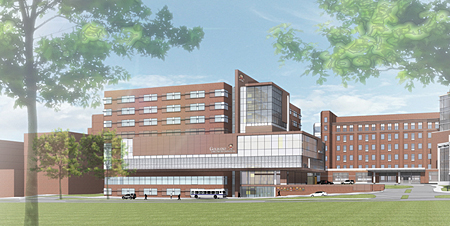
Rendering of the new Golisano Children’s Hospital
On March 29, the largest capital project in University history came closer to life as renderings of the new Golisano Children's Hospital and accompanying floor plans were unveiled. Nina F. Schor, M.D., Ph.D., the William H. Eilinger Chair of Pediatrics and Pediatrician-in-Chief, explained that the new design is a better reflection of how medicine is practiced now as opposed to 35 years ago when the Hospital was first constructed. “The original thinking was the family should be spared the anguish of being with their child when medical treatment was being undertaken and when the child was ill,” said Dr. Schor. “We now know that was exactly the wrong attitude.”
Dr. Schor described how modern medicine demands that parents must understand the child’s illness so they can be involved in the planning and execution of the treatment. Care of this kind requires much more physical space and privacy, both of which are amply allotted in the new facility. This mentality also extends beyond the patient rooms.
From the arrangement of the floors to the Hospital’s décor, the design “incorporates the totality of children’s care,” as described by Bradford C. Berk ’81M (MD), ’81M (PhD), University senior vice president for health sciences and CEO of the Medical Center. “It’s a setting that provides an opportunity for open communication. Family members can ask questions and provide information, and all members of the medical team can weigh-in . . . It helps establish an enhanced relationship and better information flow between the care providers and the family.”
The approximately 245,000-square-foot tower will greatly enhance privacy and a family-centric experience with new spaces, such as a hospitality suite featuring concierge services for parents and private patient rooms that have doubled in size. The extra space and private rooms provide improved infection control and opportunities for the family to interact with the medical team.
Tom Golisano’s exceptional generosity has bolstered Rochester’s ability to deliver Medicine of the Highest Order. In July 2011, his $20 million gift jumpstarted these plans to make the vision of a new dedicated Golisano Children’s Hospital a reality. The innovative designs were influenced by input from physicians, nurses, therapists, child-life specialists, and members of the community who have used the Hospital’s services. Additionally, they were influenced by children’s hospitals around the country.
“This has been an enormous opportunity not only for us as professionals to configure the Hospital so it serves what we need to do for children and families, but also for us to bring those children and families in and ask, ‘What would you do differently?’” said Dr. Schor. “We’ve learned a lot about how to design a building, and together we have explored as a community how we should deliver care to children and their families.”
The new Hospital is a key component of the Golisano Children’s Hospital’s $100 million campaign, which was launched publicly on October 29, 2011. In addition to the new facility, the campaign seeks to enhance education, research, and clinical practice in seven key priority areas of pediatric care: autism spectrum disorders, cancer, cardiovascular disease, eating disorders, neonatology, supportive care, and surgery. The Golisano Children’s Hospital campaign is part of the Medical Center’s $650 million campaign and the overall $1.2 billion goal of The Meliora Challenge: The Campaign for the University of Rochester.
For more information on how to support the development of the new Golisano Children’s Hospital and to take a virtual tour, visit www.givetokids.urmc.edu.
Values and Action
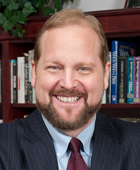 The Meliora Challenge is centered around five critical objectives that will enable us to make the world ever better: support for students, faculty, priority strategic programs, facilities, and the Annual Fund. I am proud to report that our progress in each of these areas is either on track or currently ahead of plan, and we have reached another important milestone of the Campaign. We have recently exceeded two thirds of our $1.2 billion goal by surpassing $800 million. It is the strength of our initiatives and the enduring nature of your leadership support that gives me confidence in our ability to continue this great momentum.
The Meliora Challenge is centered around five critical objectives that will enable us to make the world ever better: support for students, faculty, priority strategic programs, facilities, and the Annual Fund. I am proud to report that our progress in each of these areas is either on track or currently ahead of plan, and we have reached another important milestone of the Campaign. We have recently exceeded two thirds of our $1.2 billion goal by surpassing $800 million. It is the strength of our initiatives and the enduring nature of your leadership support that gives me confidence in our ability to continue this great momentum.
This issue of Fast Forward showcases diverse giving across our University and our five key objectives. Your support is changing and improving lives by honoring faculty and the great work they do, funding vital scholarships, expanding educational opportunities, enabling research, and building a new Children’s Hospital. We have embarked on a challenge of exceptional importance and impact. Because of your leadership, dedication, and commitment, we are on track to meet our goals and define the future of the University of Rochester. Much remains to be done, but together we will do it!
Meliora!
James D. Thompson
Senior Vice President
Chief Advancement Officer
Record Attendance Highlights George Eastman Circle’s Growth
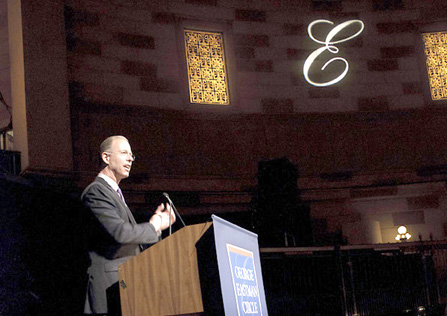
George Eastman Circle National Chair Nathan Moser
Reflecting a year of remarkable growth and impact, more than 425 George Eastman Circle members and guests celebrated in Gotham Hall, the setting for this year's annual New York City George Eastman Circle Dinner, on March 15. Members celebrated their fifth year with the highest event attendance in its history.
Alumni and friends heard remarks from Board Chair Ed Hajim ’58, Trustee and George Eastman Circle National Chair Nathan Moser ’75, Trustee and Annual Giving Programs Chair Gwen Greene ’65, student Nathan Novosel ’12, and President Joel Seligman. The New York Times columnist and bestselling author Maureen Dowd provided the evening’s keynote address and Victoria Paterson ’93 led musical selections played by the Lumière String Quartet during the reception and throughout dinner.
It was an evening energized by accomplishment and celebration. Over the past year, the George Eastman Circle has grown by nearly 20 percent, with more than 2,100 memberships representing 42 states and 12 countries. Membership eclipsing 2,000—a milestone that was recently surpassed—was lauded throughout this spectacular evening.
George Eastman Circle members have committed more than $38 million toward the $130 million Annual Fund goal of The Meliora Challenge. Nathan Moser shared the importance of broadening the George Eastman Circle—a message that was echoed by each speaker during the dinner.
“Continuing our momentum and significant growth within the George Eastman Circle will play a pivotal role in achieving The Meliora Challenge’s Annual Fund goal. We will get there one person at a time,” said Nathan. “Think of the ‘plus one approach.’ If each person in this room invites one person to join, we will make a world of difference. The impact we are making is incredibly impressive. We are a national model of leadership giving.”
Continuing to focus on building membership—in addition to sustaining and upgrading commitments—increases the George Eastman Circle’s impact on the University’s faculty, students, schools, units, and the community it serves. Much of this wonderful support was illustrated in the recently published 2011 Honor Roll. Giving from the Circle enhanced student scholarships, ensured the continued delivery of patient- and family-centered care, supported new and innovative programming, and enriched cultural experiences, making the University ever better.
To learn more about the George Eastman Circle, please visit our Web site at: www.rochester.edu/giving/gec. To view a photo gallery of the George Eastman Circle Dinner, click here.
Inaugural Ferrari Humanities Symposia Welcomes Renowned Scholar
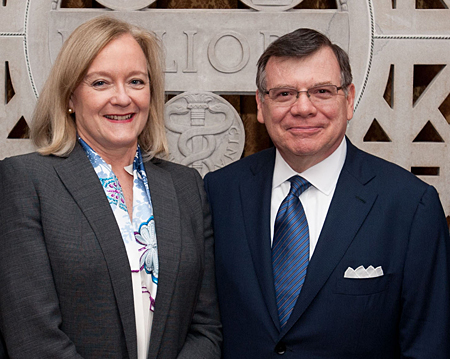
Linda Gaddis Ferrari and Bernie Ferrari
Anthony Grafton, the Henry Putnam University Professor of History at Princeton University, was the featured visiting scholar at the inaugural Ferrari Humanities Symposia, on March 21. His lecture, “Maps of Time: Science, Scholarship, and History in Early Modern Europe,” focused on the study of chronology—the science of arranging events in order of their occurrence in time. Professor Grafton joked to the large audience in attendance that the common perception of chronology was that it seemed like “the least attractive field of learning.” With brilliance, Professor Grafton's lecture provided many fascinating illustrations of important questions addressed by his field, and demonstrated quite the opposite was true.
In the Hawkins-Carlson Room of Rush Rhees Library, Thomas Slaughter, the Arthur R. Miller Professor of History, introduced his former professor and the symposium's distinguished keynote speaker as “intellectually generous.” His warm characterization of Grafton's graceful teaching style described how Professor Grafton often made arriving at a complex thought or solution seem incredibly uncomplicated.
Professor Grafton’s lecture began by discussing The Republic of Letters, a term used to refer to a community of intellectuals developed through reading. For centuries, this network was based on the writing and exchange of letters. The multidisciplinary nature of these exchanges set the stage for a time when polymaths, or Renaissance men, such as Isaac Newton, Gottfried Leibniz, and Joseph Scaliger (the Einstein before Einstein), endeavored to map the history of the world. The results of their process were transformational, making history a large inquiry of Biblical accounts. In a non-secular time, chronology became a model for interdisciplinary study. Despite chronology’s depth and complexity, Professor Grafton discussed it in a way which made it accessible and palatable for the casual attendee, truly capturing the spirit of the Ferrari Humanities Symposia.
University Trustee Bernard (Bernie) T. Ferrari ’70, ’74M (MD) and his wife, Linda Gaddis Ferrari, established the symposia with the intention of broadening the liberal education of University undergraduates. Each year, a visiting scholar of humanistic thought will hold a lecture and participate in a short, intensive course—with an emphasis on the 14th through 17th centuries—taught by faculty members from across the University. Coinciding with Professor Grafton’s lecture this year is a new course titled, “The Art and Science of Time,” which will be taught by nine faculty members from six academic departments, including art, physics, and English.
In his lecture, Professor Grafton highlighted how the early modern world produced generalists, as opposed to today's world predominantly of specialists. In the spirit of the modern classicists, Bernie and Linda’s gift provides an opportunity for undergraduates, regardless of their major, to enrich their courses of study, and broaden their intellectual spectrum.
“In an age when the value of a liberal education is increasingly challenged, Bernie and Linda are vigorous champions of the ideals embodied in our curriculum,” said Peter Lennie, senior vice president and the Robert L. and Mary L. Sproull Dean of the Faculty of Arts, Sciences and Engineering.
To commemorate the inaugural Ferrari Humanities Symposia and as a token of the University’s gratitude for their generosity, President Joel Seligman presented the Ferraris with an astrolabe—an astronomical device that was used in classical antiquity including through the Renaissance period. Performing more that 100 calculations, the astrolabe solved problems relating to time and the position of the sun and stars in the sky. The astrolabe was chosen particularly for its relevance to the theme of Professor Grafton’s lecture, as many of the scholars mentioned were likely to have used one. In his welcoming remarks, University Trustee Bob Witmer ’59 referred to Bernie as a “Renaissance man.” President Seligman added to that notion by denoting the Ferraris as a “Renaissance couple.”
“The Ferraris celebrate the life of the mind. And there’s no better illustration of what a university is about,” said President Seligman.
To view a photo gallery of the event, click here.
Roger and Carolyn Friedlander Establish Professorship to Honor an Admired Friend
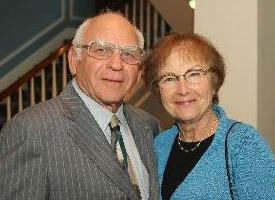
Roger and Carolyn Friedlander
For more than 35 years University Trustee Roger Friedlander ’56 and his wife, Carolyn Friedlander ’68N, have shown unwavering dedication to the University, through endowed scholarships, the George Eastman Circle, capital improvements to Rush Rhees Library, and the Eastman School of Music. Recently, their generosity took the form of a professorship, demonstrating that philanthropy can be one of the most meaningful ways to honor a respected friend. With a gift that also supports a top Campaign priority, the Friedlanders established the Dr. Elizabeth R. McAnarney Professorship in Pediatrics Funded by Roger and Carolyn Friedlander.
“As longtime friends of the University and the Medical Center, we are deeply grateful to the Friedlanders for their decades of generosity and for establishing a professorship to honor one of our most esteemed and accomplished faculty members,” said Bradford C. Berk ’81M (MD), ’81M (PhD), University senior vice president for health sciences and CEO of the Medical Center.
With this professorship, the Friedlanders are honoring Dr. Elizabeth “Lissa” McAnarney, professor and chair emerita of pediatrics at the Medical Center, for her lifetime of work benefitting children. “Roger and Carolyn’s gift is significant,” explained President Joel Seligman, “because it honors scholarship and faculty excellence. Lissa McAnarney embodies the very best of academic medicine; she’s a truly respected scientist, teacher, and clinician, who is richly deserving of this honor.”
The Friedlanders’ friendship with Dr. McAnarney is rooted in a shared passion for supporting children and their families. “We are so fascinated and intrigued by what she has done for children all over the world. She was the perfect person to recognize in this way,” said Roger. “This is not just financial involvement; it’s heart to heart.” Roger was serving as chair of the Children’s Hospital fundraising board when Dr. McAnarney was named the sixth chair of the Department of Pediatrics and pediatrician-in-chief of what is now Golisano Children’s Hospital. However, Dr. McAnarney was already familiar with the Friedlanders through Carolyn’s work as a dedicated pediatric nurse practitioner at Elmwood Pediatric Group.
“It is a singular honor to be acknowledged by one’s University and by cherished friends with the creation of a professorship in one’s name. There is no other acknowledgement in academics that resonates so deeply,” said Dr. McAnarney.
Roger and Carolyn’s gift supports the Golisano Children’s Hospital’s $100 million campaign. The Children’s Hospital campaign is part of the University of Rochester Medical Center’s $650 million campaign and the overall $1.2 billion goal of The Meliora Challenge: the Campaign for the University of Rochester. Professorships―a top priority―help Rochester attract and retain world-renowned faculty. The Dr. Elizabeth R. McAnarney Professorship in Pediatrics Funded by Roger and Carolyn Friedlander will be held by Richard E. Kreipe, M.D., professor of pediatrics and a protégé of Dr. McAnarney’s.
This professorship continues to build the Friedlanders’ legacy of giving their time, talent, and treasure. Roger is a member of the Campaign Cabinet and Medical Center Board of Directors. He chairs the School of Nursing National Council, of which Carolyn is also a member. He is a Golisano Children’s Hospital trustee, a current member of the Simon School Executive Advisory Committee, and on the Board of Directors for Eastman Institute for Oral Health and Strong Partners Health System. Carolyn is a docent of the Memorial Art Gallery and a longtime member and former chair of the Memorial Art Gallery’s Board of Managers. Roger and Carolyn are Charter Members of the George Eastman Circle at the Patron level.
Ani and Mark Gabrellian Endow Professorship and Support Research
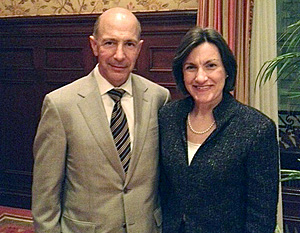
Mark and Ani Gabrellian
The Meliora Challenge seeks not only to create an improved University and strengthen our region, but also to serve our nation and the world. Ani Gabrellian ’84 and Mark Gabrellian ’79 have championed the spirit of these goals through a gift of $1.5 million to establish the Ani and Mark Gabrellian Professorship and an additional $66,000 to fund the Mesrob Mashtots Innovation Grant program. The Gabrellians’ support ensures the most creative faculty and student minds have the resources to pioneer solutions to some of humankind’s most pressing problems.
“I am deeply grateful to Ani and Mark Gabrellian for their commitment to our faculty and students,” said President Joel Seligman. “The breadth of their experience in both the private and public sectors has given them an acute appreciation for scholarship. Their commitment to the next generation is exemplary.”
The Ani and Mark Gabrellian Professorship was inspired by the Gabrellians’ recognition of the strained relationship between government officials and the private sector. A disconnect between the two sides has been caused by a general misunderstanding and/or lack of knowledge of how each side must function. The professorship aims to target this divide. Through a combination of several University disciplines and a focus on the political, economic, global, and historic problems of our time, the multidisciplinary professorship will foster the understanding of the most vital political and economic issues of our era.
“We believe the challenges facing society now and in the future will increasingly require analytical and problem-solving approaches that transcend individual disciplines,” said Ani. “Moreover, we recognize that there is increasing interest among academics and prospective students in multidisciplinary scholarship and teaching.”
While their gift promotes cross-disciplinary learning, it also provides students with the opportunity to enrich their education outside the classroom and develop the skills they will need to become leaders in their fields. Named after Armenian scholar, Mesrob Mashtots—inventor of the Armenian alphabet—the Mesrob Mashtots Innovation Grant program was established by the Gabrellians in 2010. The grants will be awarded to three outstanding, incoming undergraduate students each year. These funds can be used to take on an unpaid internship, conduct independent research, engage in a service-learning project, or for other practical experiences that complement classroom education.
As undergraduates, the Gabrellians were drawn to multiple disciplines and both were double majors: Mark in political science and history and Ani in political science and economics. Ani and Mark went on to receive a degree in business administration from George Washington University in Washington, D.C., and a law degree from the University of California, Davis, respectively. Today, they work together in their New Jersey-based real estate development and management company, Gabrellian Associates.
“We believe in the concept of endowment,” said Mark. “The beauty of an endowment is that it lasts in perpetuity and will grow over time. This is a gift based on a belief in the future.” Ani and Mark are committed to supporting the University through these gifts and as Charter Members of the George Eastman Circle at the Benefactor level.
Nathaniel and Helen Wisch Establish Professorship in Biology
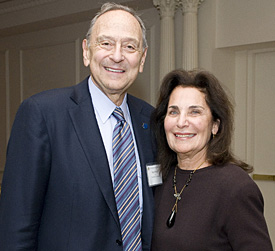
Nathaniel and Helen Wisch
University Trustee and passionate alumnus Dr. Nathaniel “Nat” Wisch ’55 is one of many alumni who, over the years, are reminded of the professors who mentored and inspired them as students. Nat, with his wife, Helen, took his memories a step further by supporting the department that had a hand in creating them. The Nathaniel and Helen Wisch Professorship in Biology is an enduring gift which honors scholars who are advancing the field of biology and serving as an inspiration for their students.
“Nat Wisch has lived the ideals of the University of Rochester as a student, a professional, and a trustee,” said President Joel Seligman. “His generous gift is a sign of his commitment to those ideals, and it will significantly help us to better meet the needs of our students for many generations to come.”
Nat and Helen created the professorship to ensure Rochester continues to attract and retain the very best researchers and educators. Leading expert in evolutionary genetics, Professor John “Jack” Werren will be the first recipient.
“Professorships are a wonderful way to acknowledge the excellence of the contributions of our faculty,” said Joanna Olmsted, dean of the School of Arts and Sciences. “The first incumbent of this professorship, Professor John Werren, is an outstanding example of this commitment to research and education.”
Professor Werren’s research, which combines genetic, molecular, and population studies, aims to better understand diseases that involve inappropriate growth, such as cancer. One of his most recent accolades is an NIH grant, funding the exploration of the venoms of parasitic wasps as a possible resource for new drug discovery.
“Top-rated faculty members go where they can get named professorships,” said Nat, who received a reminder of high caliber faculty he enjoyed as a student, when he met with his former professor, William Muchmore, a few years ago. As their visit progressed, Professor Muchmore surprised Nat with notes on his grades, dissections, and other course activities from their class―more than 50 years ago. “He described what I did right and what I could have done better. It was a sign he truly cared about his students.”
Nat enrolled at the University in 1951 with intentions of studying physics, but quickly had a change of heart. It’s a risk that many students take, but one Nat never regretted. “Spectacular” professors, as he described them, such as Professor Muchmore, gave Nat the belief that he could accomplish anything. The Nathaniel and Helen Wisch Professorship in Biology ensures future Rochester biology students are able to benefit from the same experience.
With their generosity, Nat and Helen are supporting The Meliora Challenge’s goal of establishing 80 new professorships. This goal is reflected in the Campaign’s key objective of $350 million in faculty support and the overall goal of $1.2 billion. Endowed professorships are a priority of the Campaign for their ability to help Rochester compete successfully for world-class faculty.
Nat is currently on the faculty of the Mt. Sinai School of Medicine as a clinical professor of medicine and has remained an active advocate of Rochester. In addition to being a trustee, Nat is a member of the Eastman School of Music National Council and co-chairs the New York New Leaders Regional Cabinet. Rochester remains a special place for both he and his wife, as part of their courtship took place here. Both are Charter Members of the George Eastman Circle at the Founder level.
Del Monte Distinguished Professor in Neuromedicine Installed
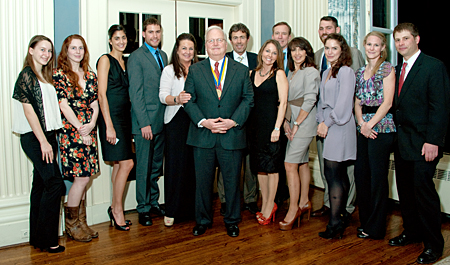
Dr. Webster Pilcher and members of the Del Monte family
Webster H. Pilcher ’83M (MD), ’83M (PhD), ’89M (Res) was installed as the first Ernest and Thelma Del Monte Distinguished Professor in Neuromedicine on March 20. Family, friends, supporters of the Ernest J. Del Monte Neuromedicine Institute, and Medical Center faculty gathered at the Genesee Valley Club for a night that honored Dr. Pilcher for his commitment and work as a clinician, scientist, and educator, and recognized the generous support of Ernie Del Monte, his late wife Thelma, and the Del Monte family.
University Life Trustee Ernie Del Monte established the professorship to show his appreciation for the Medical Center’s health care services and its broad mission of education and research. President Joel Seligman noted, “The good Ernie has done will be felt for decades and continue on for centuries.”
Concurrently, it is because Ernie has been such an ardent supporter of progressive research programs that the Neuromedicine Institute has been able to translate neurobiological discoveries into services and treatments, creating better health for all.
“Thanks to Ernie’s support, we have been able to take our nationally recognized program to a new level,” said Bradford C. Berk ’81M (MD), ’81M (PhD), University senior vice president for health sciences and CEO of the Medical Center.
The professorship was also created to recognize Dr. Pilcher for his outstanding contributions to the Department of Neurosurgery and vision for the Del Monte Institute. Dr. Pilcher was appointed chair of the department in 2002. Since taking on the role, he has been instrumental in the department’s development, initiating growth that has earned the program a spot in the top 50 of the latest U.S. News & World Report rankings.
School of Medicine and Dentistry Dean, Mark Taubman, M.D., explained that Dr. Pilcher’s goal is to bring a large group of scientists, working among eight departments and within different centers, into one state-of-the-art research building. Ernie and his family’s philanthropy have been integral in bringing this to fruition. Dean Taubman punctuated this point by emphasizing the importance of professorships.
“An endowed professorship is the best way in academia to say, ‘You’re outstanding,’” said Dean Taubman. “They provide stability during low points in funding and allow faculty members to think outside of the box and take chances. The security and freedom are critical to innovation.”
Through The Meliora Challenge, the University intends to create 80 new professorships by June 30, 2016. The Ernest and Thelma Del Monte Distinguished Professorship in Neuromedicine is just one of the ways Ernie has exemplified enthusiastic support of the University.
Third Annual Scholarship Dinner Sets New Record

Record number of donors and students attend third annual scholarship dinner
Education is critically important to our nation’s future, and Rochester is positioned to educate the leaders who will define the next generation. Endowed scholarship support ensures the brightest students can attend the University regardless of their finances. On April 11, the University celebrated the pursuit and gift of knowledge at the third annual Celebration of Scholarships dinner.
Board Chair Ed Hajim ’58 welcomed a record audience of more than 220 generous scholarship supporters, student recipients, and University leadership who gathered at the Memorial Art Gallery to recognize donors and the talented students who benefit from their remarkable philanthropy. Ed, speaking personally as a scholarship benefactor, urged guests to engage the students in conversation about their dreams and the importance of their scholarships. President Seligman, citing outstanding alumni, stressed the importance of continuing Rochester’s tradition of attracting and retaining students with an ambition to excel.
The meaning of a scholarship varies from student to student. A scholarship could mean a nurse practitioner’s master’s degree that influences the care of children and families. It could mean conducting research among Danish health care providers and patients. Or it could mean pursuing a career that combines the arts with international politics. These possibilities are actualities for three scholarship recipients who spoke and performed during the program: Bradley H. Forsythe ’14N, recipient of the Mabel M. and A. T. Hatch Memorial Scholarship; Julia C. Frisk ’12, recipient of the Constantino Family Scholarship; and Garrett M. Rubin ’13E, recipient of the William and Jocelyn Macy Sloan Scholarship.
Scholarships play a critical role not only in higher education, but also in our society. Trustee Nancy Lieberman ’77, who is also co-chair of the Scholarships Initiative for The Meliora Challenge, highlighted why scholarships are a leading priority of the Campaign. Of the Campaign’s $1.2 billion goal, $225 million will support students, primarily through scholarships and fellowships.
“Education is a gift—it’s the great equalizer,” said Nancy, who went on to address the financial obstacles and burdens which often come with the pursuit of higher education. For these reasons, she encouraged students who have received scholarships to give back and continue the chain of giving. She described how her education helped get her to where she is today, and why that motivated her to create the Nancy A. Lieberman Scholarship at Rochester.
Garrett Rubin ’13E, accompanied by Yi-Wen Lai ’13E (MM) on the piano, brought the evening to a moving close by performing an aria from the opera L’infedeltà delusa by Joseph Haydn. He then led the room in the traditional singing of “The Genesee.”
To view an online gallery of photos taken during the dinner, please click here.